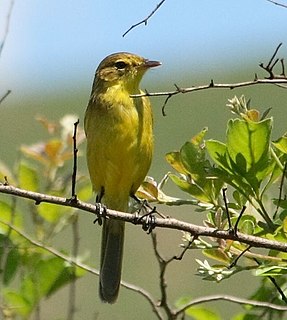 W
WChloropeta was a genus of Acrocephalidae warblers; formerly, they were placed in the paraphyletic "Old World warblers". Now the papyrus yellow warbler is placed in its monotypic genus Calamonastides, with the others placed in the genus Iduna.
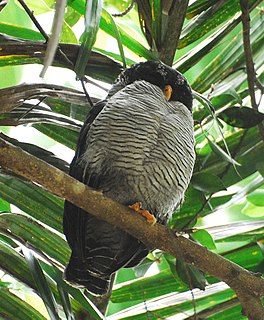 W
WCiccaba was a small genus of typical owls found in the Americas. It contained 4 species but they have now been transferred to Strix:Mottled owl, Strix virgata Black-and-white owl, Strix nigrolineata Black-banded owl, Strix huhula Rufous-banded owl, Strix albitarsis
 W
WThe "Corvida" were one of two "parvorders" contained within the suborder Passeri, as proposed in the Sibley-Ahlquist taxonomy, the other being Passerida. Standard taxonomic practice would place them at the rank of infraorder.
 W
WGalliformes is an order of heavy-bodied ground-feeding birds that includes turkey, grouse, chicken, New World quail and Old World quail, ptarmigan, partridge, pheasant, guineafowl, francolin, junglefowl, peafowl (peacock), and the Cracidae. The name derives from "gallus", Latin for "cock" or "rooster". Common names are gamefowl or gamebirds, landfowl, gallinaceous birds, or galliforms. "Wildfowl" or just "fowl" are also often used for the Galliformes, but usually these terms also refer to waterfowl (Anseriformes), and occasionally to other commonly hunted birds. This group has about 290 species, one or more of which are found in essentially every part of the world's continents. They are rarer on islands, and in contrast to the closely related waterfowl, are essentially absent from oceanic islands—unless introduced there by humans. Several species have been domesticated during their long and extensive relationships with humans.
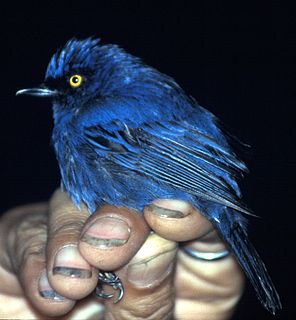 W
WDiglossopis was a genus of blue flowerpiercers in the family Thraupidae. They are now usually placed in the genus Diglossa. They were formerly classified in the bunting and American sparrow family Emberizidae, more recent studies have shown it to belong in the Thraupidae. They are restricted to highland forest and woodland from Venezuela and Colombia, through Ecuador and Peru, to Bolivia.
 W
WErgaticus was a genus of New World warblers — small passerine birds found only in the Americas. It was subsumed into Cardellina in 2011. The name is the Latinized version of the Ancient Greek ergatikos, meaning "willing or able to work". The genus contains two sister species: the red warbler, which is endemic to the Mexican highlands north of the Isthmus of Tehuantepec, and the pink-headed warbler, which is found south of the Isthmus, from the highlands of Chiapas, Mexico down into Guatemala. Though they are separated by geography and differ considerably in plumage, the two have sometimes been considered to be conspecific.
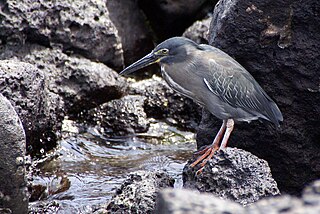 W
W"Green-backed heron" is a collective term for certain herons. Small and compact among herons, these birds often feature green plumage – rare among the Ardeidae –, in particular on the back, wings and scapulars.
 W
WHarpyhaliaetus is a former genus of eagles. Recent studies have shown that the solitary eagle is closely related to the black-hawks, in particular the savanna hawk which is smaller and browner but otherwise very similar to Harpyhaliaetus. Therefore, this genus is now merged into that of the black-hawks.
 W
WHylocryptus was a genus of birds in the family Furnariidae. The AOU has merged the genus into Clibanornis.
 W
WMacrodipteryx was a genus of African nightjars consisting of two species: the pennant-winged nightjar and the standard-winged nightjar. They inhabit subtropical woodlands and the males of both species acquire strikingly elongated primaries in the breeding season. However, the former genus is now considered to be a synonym of Caprimulgus Linnaeus, 1758.
 W
WPadda is a genus of estrildid finches restricted to islands in southern Indonesia.
 W
WParula was formerly a small genus of New World warblers which breed in North and South America.
 W
WSpreo is an alternative genus of starling in the family Sturnidae. They are now usually lumped in the genus Lamprotornis. It contains the following species:
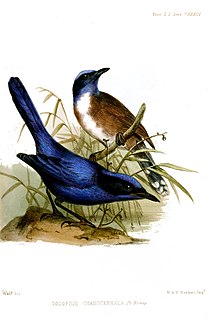 W
WTodopsis is a former genus of fly-catching wrens. The following species were formerly classified within the genus Todopsis:Wallace's fairywren Broad-billed fairywren Emperor fairywren Emperor fairywren (mysorensis) Emperor fairywren (bonapartii)
 W
WTotanus is a generic name previously applied to various waders or shorebirds, now subsumed within Tringa. Created by Johann Matthäus Bechstein, it derives from the species name for the common redshank, described by Carl Linnaeus in his landmark 1758 10th edition of Systema Naturae as Scolopax totanus, from totano, the Italian name for the bird.
 W
WWilsonia is a small genus of New World warblers which breed in North America. They are migratory, wintering south of their breeding ranges in Central America, the West Indies or South America.